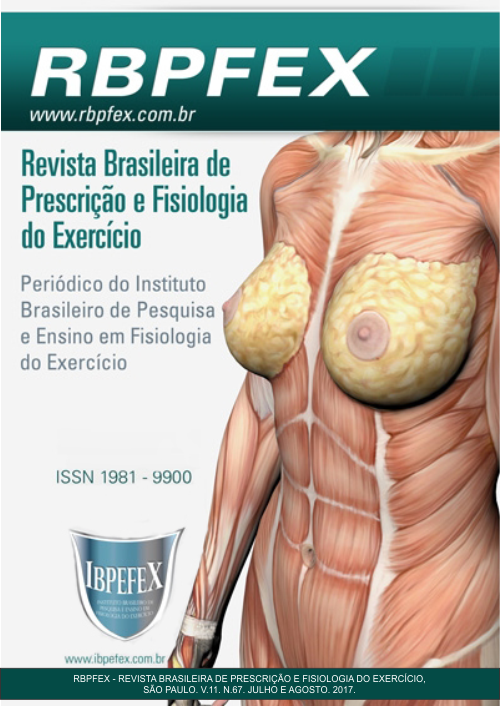Jump teste to evaluate the volleyball player
Abstract
The objective of the review was to explain the most important jump tests for the volleyball player. The literature informed that the strength has two groups: active and reactive. The active strength is composed by explosive strength. The reactive strength is composed by elastic explosive strength and reflex elastic explosive strength. The jump test for evaluate the explosive strength is with the squat jump, but for evaluate the elastic explosive strength is with the countermovement jump, the test for evaluate the reflex elastic explosive strength is with the Bosco test. However, some authors consider best the intermittent tests with several jumps. But recently, an author recommended the uses the Kinovea® software to determine the jump and the reach of the athlete during the match for measures the elastic explosive strength and/or the reflex elastic explosive strength. In conclusion, the article determined the best jump test for the volleyball player.
References
-American Volleyball Coaches Association. Coaching Volleyball. Chicago. Master Press. 1997.
-Arruda, M.; Hespanhol, J. Saltos verticais. São Paulo. Phorte. 2008.
-Badillo, J.; Ayestarán, E. Fundamentos do treinamento de força. 2ª edição. Porto Alegre. Artmed. 2001.
-Barbanti, V. Manifestações da força motora no esporte de rendimento. In. Barbanti, V.; Amadio, A.; Bento, J.; Marques, A. (orgs). Esporte e atividade física. Manole. 2002. p. 13-25.
-Barbanti, V. Treinamento esportivo: as capacidades motoras dos esportistas. Manole. 2010.
-Bosco, C.; Luhtanen, P.; Komi, P. A simple method for measurement of mechanical power in jumping. Eur J Appl Physiol. Vol. 50. Num. 2. p. 273-282. 1983.
-Harman, E.; Rosenstein, M.; Frykman, P.; Rosenstein, R. The effects of arms and countermovement on vertical jumping. Med Sci Sports Exerc. Vol. 22. Num. 6. p. 825-833. 1990.
-Hespanhol, J.; Silva Neto, L.; Arruda, M.; Dini, C. Avaliação da resistência de força explosiva em voleibolistas através de testes de saltos verticais. Rev Bras Med Esp. Vol. 13. Num. 3. p. 181-184. 2007.
-Komi, P. Physiological and biomechanical correlates of muscle function: effects of muscle structure and stretch-shortening cycle on force and speed. Exerc Sports Sci Rev. Vol. 12. Num. 1. p. 81-121. 1984.
-Olmedo, J.; Pueo, B.; Tomás, A.; Mira, J.; Turpin, A. Physiological work áreas in profesional beach volleyball: a case study. Retos. Num. 31. p. 94-97. 2017.
-Marques Junior, N. Vertical jump of the elite male volleyball players in relation the game position: a systematic review. Rev Observatorio Dep. Vol. 1. Num. 3. p. 10-27. 2015.
-Marques Junior, N. Fundamentos que fazem ponto durante o jogo de voleibol: um estudo de correlação. Rev Observatorio Dep. Vol. 1. Num. 3. p. 134-145. 2015b.
-Marques Junior, N. Estudo de um jogador do voleibol na areia: verificação do preparo físico e a identificação do fluxo sanguíneo cerebral, 1999 a 2013. Revista Brasileira de Prescrição e Fisiologia do Exercício. Vol. 9. Num. 55. p. 462-474. 2015c. Disponível em: <http://www.rbpfex.com.br/index.php/rbpfex/article/view/829/733>
-Marques Junior, N. 3º set da final do voleibol masculina dos Jogos Olímpicos de 1984. Rev Observatorio Dep. Vol. 2. Num. 3. p. 8-27. 2016.
-Marques Junior, N. Uso do software Kinovea® para os testes de controle de alguns fundamentos do voleibol. 100-Cs. Vol. 2. Num. 2. p. 51-84. 2016b.
-McArdle, W.; Katch, F.; Katch, V. Fisiologia do exercício: nutrição, energia e desempenho humano. 7ª edição. Guanabara. 2011.
-Moreno, S.; Marcelino, R.; Mesquita, I.; Ureña, A. Analysis of the rally length as a critical incidente of the game in elite male volleyball. Int J Perf Analysis Sport. Vol. 15. Num. 2. p. 620-631. 2015.
-Moreira, A.; Okano, A.; Ronque, E.; Souza, M.; Oliveira, P. Reprodutibilidade dos testes de salto vertical e salto horizontal triplo consecutivo em diferentes etapas da preparação de basquetebolistas de alto rendimento. Rev Bras Cineantropom Desempenho Hum. Vol. 8. Num. 4. p. 66-72. 2006.
-Silva, M.; Marcelino, R.; Lacerda, D.; João, P. Match analysis in volleyball: a systematic review. Monten J Sports Sci Med. Vol. 5. Num. 1. p. 35-46. 2016.
-Tricoli, V.; Barbanti, V. Avaliação da força motora. In. Kiss, P. (org.). Esporte e exercício. São Paulo: Roca. 2003. p. 199-222.
-Tubino, M.; Moreira, S. Metodologia científica do treinamento desportivo. 13ª edição. Shape. 2003.
-Verkhoshanski, Y. Força: treinamento da potência muscular. Londrina. CID. 1996.
Authors who publish in this journal agree to the following terms:
- Authors retain the copyright and grant the journal the right of first publication, with work simultaneously licensed under the Creative Commons Attribution License BY-NC which allows the sharing of the work with acknowledgment of the authorship of the work and initial publication in this journal.
- Authors are authorized to enter into additional contracts separately for non-exclusive distribution of the version of the work published in this journal (eg, publishing in institutional repository or book chapter), with acknowledgment of authorship and initial publication in this journal.
- Authors are allowed and encouraged to post and distribute their work online (eg, in institutional repositories or on their personal page) at any point before or during the editorial process, as this can bring about productive change as well as increase impact and impact. citation of published work (See The Effect of Free Access).






